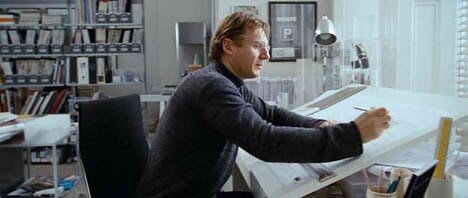What Does an Architect Do?
There are plenty of ways to go about a building project. As a firm we find that the role of the architect is often misunderstood or not entirely clear. Often people aren’t aware of the role architects have in a project. Fuelled by budget restraints, many people in Australia opt to buy a project home or to go to a draftsperson. The reality is, architects do charge a considerable amount of money and design a lot of high end buildings. The stereotype is essentially an egocentric turtle neck wearer and people understandably fear engaging in a design process where they fundamentally want to be heard.
Liam Neeson sporting his turtleneck as architect Daniel in the film Love Actually
So, what is an Architect?
Architects have been coined the ‘master generalists,’ knowing a lot about everything in order to tie together all the specialist consultants involved in a project. As well as creative input, architects provide project management along with cost planning management, especially on smaller scale jobs. This part of the job isn’t too glamorous or exciting but are intrinsic aspects of any building project.
Architects offer good design, space efficiency, functionality, cost effectiveness, passive design, good orientation to the context of the site all the while being sustainable and aware of practices that are better for the world. These all assist the production of a building that has a superior design outcome and ultimately, a longer lifespan.
What is good design?
After some discussion, our office agreed that good design is something that withstands the test of time. A space that is comfortable and enjoyable to live in. To us, in summary, this means a building that prioritises passive solar design, good views, good circulation and connectivity between different spaces while being flexible and allowing for different users to occupy the space and make it their own.
Two examples of residential projects completed by our office
Architect Vs. Draftsperson
What we do as architects, is based on all of the experience we have as well as the study and knowledge that we’ve acquired. On the other hand, a drafting service only produces technical drawings. We also, as designers are lateral thinkers and we try to understand the client and context to then find the outcome that best reflects their desires. Inadvertently, the best outcome we can hope for is when presenting a design to a client and the response is ‘Oh, I hadn’t thought of that!’
(L) Aerial photo of a house designed for a client in Inner Melbourne (centre of image). As Architects we use our experience, and lateral thinking skill, to create designs that respond to context, are comfortable to live in, and respond to client lifestyles.
(R) In contrast, a drafting service only provide technical drawings, and do not have the same level of design thinking as an Architect. This often leads to generic outcomes that do not reflect the individual nature of location and client requirements.
What can I expect when working with an architect?
In a recent talk by Brisbane based Architect Timothy Hill that members of our team attended, Hill explained that the public knows what an architect is outside of the context of architecture. We hear it in football games when a player organises and leads people. The architect designed perhaps the play that won the game. We hear it in reference to taking responsibility, delivering an outcome. People know what the word alludes to though when it comes to the profession, it’s often forgotten that that is what we do in terms of a building.
As architects, we’ll take you on a design journey. Upon a design journey, we’ll assist going as far as you’re comfortable in terms of sustainable design, budget etc. to maximize the outcome and inherent joy of the building.
The initial stages involve retrieving all the information a client has so we can understand what they are trying to achieve. An architect will be able to view a projects parameters and culminate ideas and concepts through a different way of thinking and testing. A whole lot of testing! If this process is missed and you jump straight to drafting, you may be off on the wrong track because the design hasn’t been tested in a fundamental way.
Through this process, a concept design will be developed. After this, along with the application for a town planning permit if required, the design progresses through the design development phase which is followed by a technical drawing and documentation stage to enable tendering the project to the market where we then manage negotiation with builders. Once on site, we deal with the contract and administration of the building process.
How do I choose an Architect?
You’re going to be involved in a reasonably lengthy process with the architect or team that you engage. When choosing an architect, you want to make sure you feel comfortable, heard and that the architects are approachable and excited about being on a journey with you. A question you can ask yourself when choosing an architect is, how do you imagine communicating with this person as there’s always going to be things you don’t agree with. Alongside being a generalist, an architect is also a mediator. Within the architectural journey, there are always differences in personalities and priorities but fundamentally, all parties should see value in striving to make good architecture within the set parameters.



